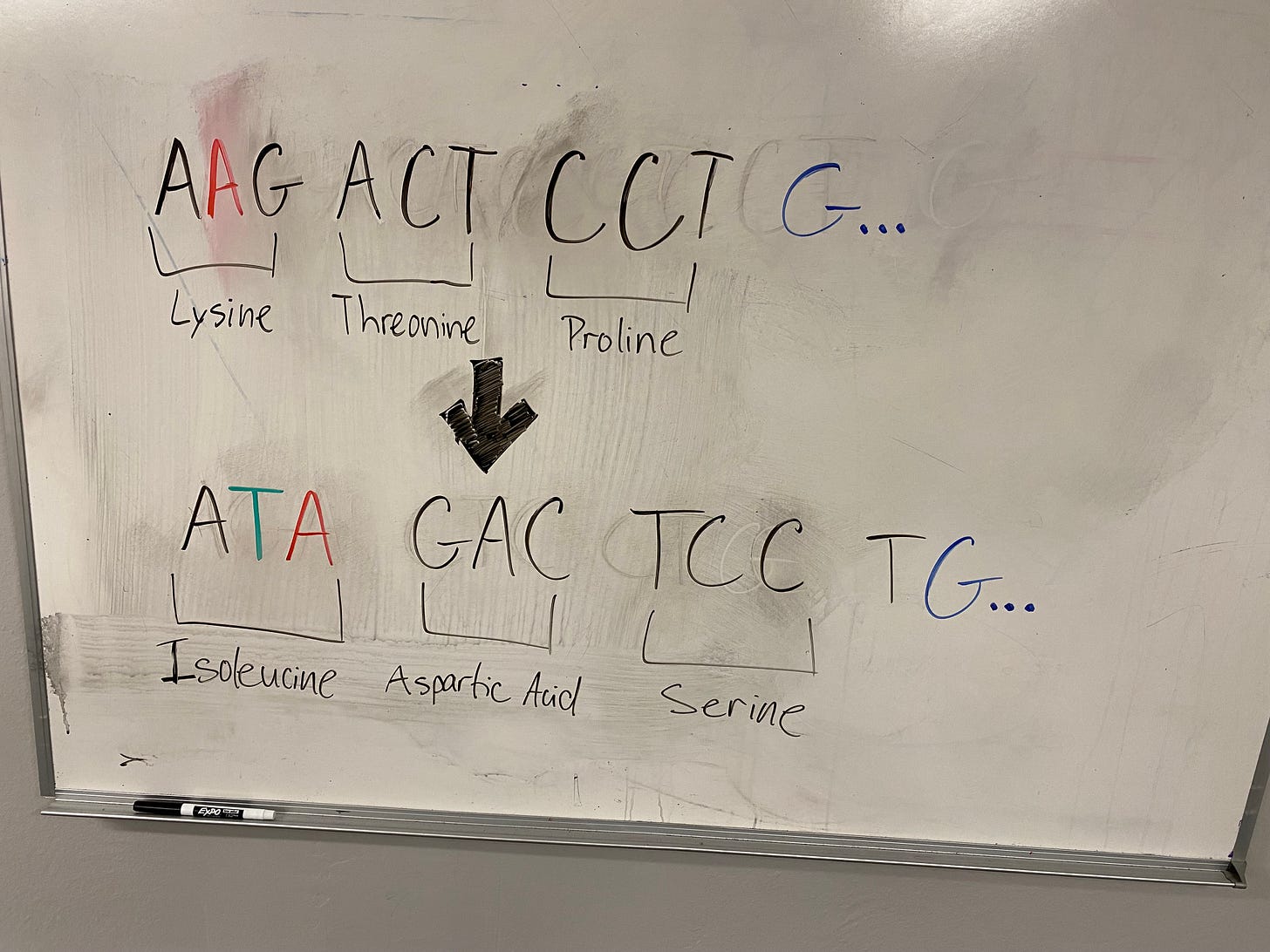Current Investigations In Cancer Cell Biology Part III: Mutations 101
The little things matter.
In the Army, soldiers use the saying, “One ‘awe shit’ can fuck up a thousand ‘atta boy’s,’” to describe the fragility of reputations and the severity of consequences that exist in the business of warfare. As I alluded to in the last post in this series, this fragility exists in the world of cancer biology as well, in that changing one nucleotide — a structure that is a mere 6.0 x 10-10 meters long — can lead to an evolutionary stepping stone. On the other hand, it can also lead to the destructive domino effect that is the development of cancer. In this post, we will build upon the, “Genetics 101,” concepts we previously discussed and dive into the world of mutations, where minute changes to our biological coding can either make or break us. If you are not familiar with the basics of DNA, codons, and genes, then head over to the last post before going through this one.
As we discussed previously, DNA is analogous to a recipe, in that it provides the information and instructions that our cells need to build proteins. Specifically, it is the order and content of the nucleotides within DNA that make up codons — analogous to 3 letter words in the recipe — and it is those codons that determine the particular amino acids that comprise the final protein. That last part exemplifies the classic biological concept of form fitting function, in that it is the relationship between the string of amino acids that determines the protein’s form — its shape and chemical characteristics — and it is that form that determines the protein’s potential functions.
It is easy to view the concepts of protein functions through the analogy of a key and a lock, where the lock represents the protein, and the key represents the external molecules that interact with the protein. Imagine that a lock contains a certain type of metal that repels copper and attracts aluminum. In order to interact with this lock, a key would not only need to have the correct shape, but it would also need to be made of the correct material. Proteins work in a similar manner, in that their 3-D structures only allow molecules of certain shapes to enter the proteins’ active sites — analogous to the keyhole on a lock; additionally, the amino acids that constitute those active sites exhibit different chemical properties, so those molecules must also possess the proper chemical characteristics to interact with the proteins.
With that in mind, imagine how altering the nucleotide sequence in a given gene could impact the resulting protein. Think about what might happen if you show up at your house and discover somebody changed all of your locks. On one hand, maybe you got lucky and your set of keys still meets the physical and chemical requirements to interact with your locks seamlessly, or maybe your set of keys is able to fit into the locks just enough to crack the door open; contrarily, maybe the changes to those locks completely prevent your set of keys from working on any of the doors. In the latter scenario, maybe you just have to go hire a locksmith to change the locks, or maybe the house catches on fire, and you are left helpless and unable to affect anything going on inside. This situation is analogous to a genetic mutation — a change in the sequence or content of nucleotides in DNA — in that altering the content of DNA can result in a spectrum of consequences, some of which are irrelevant, some of which are moderate, and some of which are catastrophic. At their best, mutations can result in improved biological function, which is analogous to a change that allows a key to better interact with a lock, but, at their worst, mutations can result in lethal genetic disorders or cancers.
The rudimentary concepts of mutations and their consequences are simple: different combinations of nucleotides create different codons → different codons encode different amino acids → different amino acids have varying physical and chemical properties → different proteins’ functions and characteristics vary depending on their underlying amino acids; so, changing a protein’s amino acid content can change that protein’s functions and characteristics.
Yet, the complexity of mutations comes into play when considering the different types of mutations and the spectrum of impacts those mutations have on protein functions and physiological processes. For the sake of this post, we will address two categories of mutations: point mutations and frameshift mutations.
Point mutations involve substituting a single nucleotide — Adenine (A), Guanine (G), Thymine (T), and Cytosine(C) — for another. For example, a point mutation could consist of changing a codon’s nucleotide sequence from AAG to AAC. In this case, the encoded amino acid would change from lysine to asparagine, which could significantly alter the final protein structure, since lysine is a positively charged amino acid, and asparagine has no charge. This type of point mutation, where the resulting amino acid changes, is referred to as a missense mutation, and it can lead to extreme consequences if it disrupts the resulting protein’s ability to conduct reactions — some of which might be critical to our survival.
Now, imagine that the original AAG sequence changed to AAA instead. In this scenario, both sequences code for lysine, so the mutation would not affect the final protein. This type of point mutation, where there is no change in the resulting amino acid, is called a silent mutation, and it is possible because multiple codons can code for the same amino acid — the genetic concept referred to as degeneracy. Interestingly, although codons are degenerate, they are also unambiguous, in that each codon sequence only codes for a single amino acid. In theory, these qualities of codons arose to limit the harmful effects of mutations, by leaving wiggle room for alterations to DNA and also maximizing specificity.
The last type of point mutation occurs when a given nucleotide substitution turns the codon of interest into a stop codon. Stop codons do not code for any amino acid; rather, they exist as signals that terminate translation — the process where ribosomes build the final protein. In continuation with the example from above, if the AAG codon was changed to TAG, then that codon would now signal the end of translation before that protein is completely built. This type of mutation is particularly problematic, as it can result in the loss of half of the protein if it is in the middle of the gene or nearly all of the protein if it is at the beginning of the gene. In accordance with our recipe analogy, this would be like prepping and stuffing the turkey, only to realize that your dog ate the part of the recipe book with the baking instructions.
Although they can lead to drastic outcomes, point mutations often cause minimal harm because they only affect one codon at a time. Frameshift mutations, on the other hand, cause a chain reaction of issues that typically throws off every subsequent codon in a gene. These mutations result from either deleting or inserting a nucleotide in a gene, both of which shift the reading of all the other nucleotides downstream of that deletion or insertion. In this way, insertions and deletions can affect multiple codons, as they can alter the nucleotide sequences of each codon in the affected section of DNA. For example, if there were three codons AAG ACT CCT G… , and we deleted the second adenine nucleotide (shown in red below), then the sequence would change to AGA CTC CTG. If you focus on the last guanine nucleotide (shown in blue below), you will notice that all of the nucleotides following the deletion shifted down one spot in the reading frame; consequently, instead of coding for lysine, threonine, and proline, those codons would now code for arginine, leucine, and leucine.
Similarly, if we inserted a thymine nucleotide (shown in green below) before that second adenine nucleotide, then the codons would read ATA GAC TCC TG…, and they would code for isoleucine, aspartic acid, and serine. Considering that there is an average of 333 codons in a single gene, you can imagine the dramatic effect that a frameshift mutation could have by causing hundreds of missense and nonsense mutations downstream. If you take into account that multiple neighboring genes are typically expressed simultaneously, this effect amplifies.
If these complications are not complex enough for you, in addition to point and frameshift mutations, there are also inversions, duplications, repeat expansions, epigenetic alterations, post-transcriptional alterations, and post-translational alterations, all of which can affect the final protein product of the gene in question. It is these dynamic factors, starting from the genetic contents you originally inherit from your parents, that determine the functions of your proteins; consequently, any one of these factors could enhance or disrupt your physiology.
It is through mutations that humans have been able to evolve and develop the advantageous traits that allow us to dominate the Earth, but it is also through mutations that our own cells go rogue and develop the traits and capabilities that allow them to turn against us. Next time, we’ll discuss the specific mutations and capabilities that make rogue cancer cells dangerous and deadly.





